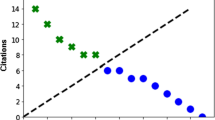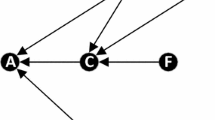Abstract
Although the conventional h-index attempts to combine a researcher’s publications and citation-based impact, it requires threshold citation counts and cited papers to award a score. The consequence is that the h-index fails to consider extra citation counts as well as uncited publications, both of which reveal a researcher’s performance output. Recently, an apparent h-index was presented to extend the conventional h-index to account for the uncited publications of a researcher; unfortunately, the apparent h-index also fails to account for a researcher’s extra citation counts. In this paper, we extend the apparent h-index to account for a researcher’s extra citation counts. In particular, contrary to the conventional h-index and its variants, the proposed author-level metric uses relative extra citation counts and uncited publications to discriminate among researchers. The relative extra citation count is defined as the ratio of the absolute extra citation counts to the total number of citations. The proposed index, called a comprehensive h-index (c-index), is formulated by incorporating the relative extra citation counts and the fraction of the cited publications into the h-index. The advantages of the c-index are two-folds: first, it enhances the discriminatory power of the h-index as it considers researcher’s entire publications, whether cited or not, and all the citation counts; and second, it preserves the desirable features of the conventional h-index, namely robustness and simplicity. Case studies for researchers in Chemistry, Physics, Material Science, Engineering and Medicine have been presented. Results show that researchers could have equal h-index, but unequal c-index due to their unequal relative extra citation counts, as well as their uncited publications. Furthermore, a comparison of the c-index with the h- and g-indices have been made; results show that the c-index is more discriminatory than both the h- and g-indices. The proposed metric may contribute to the ongoing discussions on the improvement of the conventional h-index.





Similar content being viewed by others
References
Alonso, S., Cabrerizo, F., Herrera-Viedma, E., & Herrera, F. (2010). hg-index: A new index to characterize the scientific output of researchers based on the h- and g-indices. Scientometrics, 82, 391–400.
Anderson, T. R., Hankin, R. K. S., & Killworth, P. D. (2008). Beyond the durfee square: Enhancing the h-index to score total publication output. Scientometrics, 76, 577–588.
Barnes, C. (2017). The h-index debate: An introduction for librarians. The Journal of Academic Librarianship, 43, 487–494.
Bornmann, L., Mutza, R., & Daniel, H. (2010). The h index research output measurement: Two approaches to enhance its accuracy. Journal of Informetrics, 4, 407–414.
Bihari, A., & Tripathi, S. (2017). EM-index: A new measure to evaluate the scientific impact of scientists. Scientometric, 112, 659–677.
Brown, O. R. (2012). The hb-index, a modified h-index designed to more fairly assess author achievement. Redox Report, 17(4), 176–178.
Costas, R., & Bordons, M. (2008). Is the g-index better than h-index? An exploratory study at the individual level. Scientometrics, 77, 267–288.
Dorogovtsev, S. N., & Mendes, J. F. F. (2015). Ranking scientisits. Nature Physics, 11(11), 882–884.
Egghe, L. (2006a). An improvement of the h-index. ISSI Newsletter, 2(1), 8–9.
Egghe, L. (2006b). Theory and Practice of the g-index. Scientometrics, 69(1), 131–152.
Egghe, L., Guns, R., & Rousseau, R. (2011). Thoughts on uncitedness: Nobel laureates and fields medalists as case studies. Journal of the American Society for Information Science and Technology, 62(8), 1637–1644.
Franceschini, F., & Maisano, D. (2011). Criticisms on the hg-index. Scientometrics, 82(2), 391–400.
Hadagali, G. S., Kumbar, B. D., Gourikeremath, G. N., & Hiremath, R. (2016). g-index as an improvement of the h-index: A comparative study of prominent indian scientists. International Journal of Information Dissemination and Technology, 6(51), S42-48.
Hirsch, J. E. (2005). An index to quantify an individual’s scientific research output. Proceedings of National Academy of Sciences, 102, 16569–16572.
Ho, Y.-S., & Hartley, J. (2016). Sleeping beauty in psychology. Scientometrics, 110, 301–305. https://doi.org/10.1007/s11192-016-2174-0.
Hsu, J., & Huang, D. (2011). A scaling between impact factor and uncitedness. Physica A: Statistical Mechanics and its Applications, 391, 2129–2134.
Hu, Z., Lin, A., & Willett, P. (2018). Identification of research communities in cited and uncited publications using a co-authorship network. Scientometrics, 118, 1–19. https://doi.org/10.1007/s11192-018-2954-9.
Jin, B., Liang, L., Rousseau, R., & Egghe, L. (2007). The R- and AR-indices: Complementing the h-index. Chinese Science Bulletin, 52, 855–863.
Kamat, B. (2018). Most cited versus uncited papers. What do they tell us? ACS Energy letters, 3, 2134–2135.
Kuan, C.-H., Huang, M. H., & Chen, D. Z. (2011). Positioning research and innovation performance using shape centroids of h-core and h-tail. Journal of Informetrics., 5(4), 515–528. https://doi.org/10.1016/j.joi.2011.04.003
Mohammed, S., Morgan, A., & Nyantakyi, E. (2020). On the influence of uncited publications on a researcher’s h-index. Scientometrics, 122, 1791–1799.
Nicolaison, J., & Frandsen, T. F. (2019). Zero impact: A large-scale study of uncitedness citation. Scientometrics, 122, 1227–1254.
Rousseau, R. (2006). New developments related to the Hirsch index. Berlin fourth international conference on webometrics, informetrics and scientometrics and ninth COLLNET meeting (pp. 23–25). Berlin: Science Focus.
Rousseau, R., Leuven, K. U. (2008). Reflections on recent developments of the h-index and h-type indices . Fourth international conference on webometrics, informetrics and scientometrics & ninth COLLNET meeting (pp. 1–9). Berlin: WIS.
Ruane, F., & Tol, R. S. J. (2008). Rational (successive) h-indices: An application to economics in the Republic of Ireland. Scientometrics, 75(2), 395–405.
Sidiropoulos, A., Katsaros, D., & Manolopoulos, Y. (2007). Generalized h-index for disclosing latent facts in citation networks. Scientometrics, 72, 253–280.
Jin, B. (2006). The AR-index. Complementing the h-index. ISSI Newsletter, 6, 3(1).
Todeschini, R. (2011). The j-index: A new bibliometric index and multivariate comparisons between other common indices. Scientometrics, 87(3), 621–639.
Visscher, A. D. (2011). What does the g-index really measure? Journal of the American Society for Information Science and Technology, 62(11), 2290–2011.
Zhang, C. T. (2009). The e-index, complementing the h-index for excess citations. PLoS ONE, 4, 1–4.
Zhang, C. T. (2013). The h’-index, effectively improving the h-index based on the citation distribution. PLoS ONE, 8, 1–8.
Acknowledgement
We acknowledge the support, in terms of computing facility, of University of Energy and Natural Resources, Sunyani, Ghana. The inputs of the anonymous reviewers are appreciated.
Author information
Authors and Affiliations
Corresponding author
Rights and permissions
About this article
Cite this article
Mohammed, S., Nyantakyi, E.K., Morgan, A. et al. Use of relative extra citation counts and uncited publications to enhance the discriminatory power of the h-index. Scientometrics 126, 181–199 (2021). https://doi.org/10.1007/s11192-020-03777-y
Received:
Published:
Issue Date:
DOI: https://doi.org/10.1007/s11192-020-03777-y




